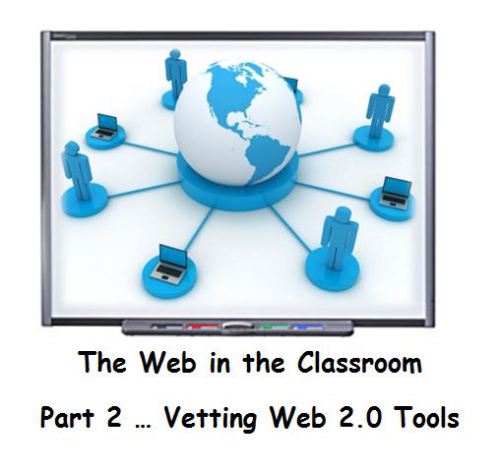Vetting Web 2.0 Educational Tools: The Web in the Classroom, Part 2

Welcome to another article in a series devoted to facilitating proper student internet interaction in the classroom. This classroom might be 1 to 1 or might be using technology to leverage student centered learning. In this post I would like to explore steps to take and reflect on when vetting a Web 2.0 interactive tool for classroom use. Before reading, please take a moment to subscribe by email or RSS and also give me a follow on Twitter at mjgormans. I promise you will find some great information coming your way this school year…So Sign up now and please pass this on with a retweet! – Mike Gorman (https://21centuryedtech.wordpress.com/)

Booking Info – It is time to think about your school or conference needs. Are you looking for a practical and affordable professional development workshop for your school or conference? I have traveled the country delivering PD relating to technology integration, PBL, STEM, Digital Literacy, and the 4 C’s. I have delivered hundreds of workshops and presentations. Check out my Booking Page. Please contact me soon if you have an interest. I am now booked through the end of December and the 2016 calendar is beginning to fill. In fact, it might be time to begin thinking about next summer!
Upcoming Opportunities:
- Join me at PBS Learning Media on Monday, November 23 at 7 PM EST for a free webinar on learning about STEM and Ocean Life through the PBS program, Big Blue Live and numerous free internet resources.. Register at this link.
- Are you traveling to Learning Forward Conference in Washington DC in December? Check out my PBL and Technology Integration Workshop. Learn more at this link.
- January is a great time to travel to Orlando and FETC. If you are attending, check out my STEM and Maker’s Session. More information at this link scroll to Concurrent Session Number 7.
I have been asked in the past to provide key questions that a district and teachers could use to vet a website. While all websites designated for class use should be previewed by the teacher, it is especially important that Web 2.0 sites go through a vetting process. While everyone may have a different definition of Web 2.0, I promote the idea that a Web 2.0 site is a site that allows for interactivity. In this interactivity, a user may be able communicate and interact with others, leave a digital footprint, store digital information, and be open to various outside sources. For this reason it is important to vet a Web 2.0 site before providing access to students.
Before vetting a site it is important to investigate procedures and policies that are in place in a school or district. First and foremost, educators should become familiar with their district AUP (Acceptable Use Policy) or RUP (Responsible Use Policy). Every district will have one of these documents describing the use of internet for educators and students. All educators and students should become familiar with this document. There may also be a separate Social Media Policy which should also be explored… if available.
A district may already have an approved vetting procedure. It is important to check and to see if this already exists. There may also be pre-approved tools and interactive(s) that are provided by the district. It is essential to investigate procedures for using these tools. The use of these tools might be grade level, school, or age specific. An educator should also understand and model proper digital citizenship while providing needed instruction for students. It is also important to see if a comparable tool is already provided as part of a district approved LMS (Learning Management System) or resource list. It is always best to check possibilities in the LMS and approved district resource lists before going out to another third party. Last, it is valuable to have a conversation with the technology department and administration. They will be able to provide important direction. Please take a moment to read a past article on Ten Ideas to Consider Before Using an Internet in the Classroom… Part 1.
After these important check points, it may be useful to investigate a Web 2.0 tool that could be beneficial in the classroom. The measure of education value should be weighed by considering content standards, skills, and ability to provide student ownership and engagement. In the vetting process it will be important to become familiar with the vetting site’s (resource or tool being explored) Privacy and Terms of Agreement. This can be found in the website, many times at the bottom of the page. There may be some legal terms you wish to define in the Terms and Privacy Documents. As one reads these policies there may seem to be road blocks. With careful vetting and conversation involving proper school district personal these blocks may turn out to be only hurdles. Some of the hurdles might include district approval, possibly parent signature, and other stipulated procedures. Below, I have some questions one should ask when vetting. Please do not view this as an inclusive list. A district may have other requirements and items decision makers wish to include. When viewing these questions please note that an answer of (Yes or Not Found) to any of these may require further investigation. Also, note that some questions go beyond a Yes, No, or Not Found Answer.
Tools and ideas to transform education. Sign up below.
A Reference Guide for Vetting a Web 2.0 Website… Not for Official Use
Please circle all grades and ages of students who would use the tool:
Grades: PK, 1…2…3…4…5… 6.. 7.. 8.. 9..10..11..12
Student Age Range: 4…5…6…7…8…9…10…11..12..13..14..15..16..17..18+
What classes in which the tool would be used:
Website Name:
Web Address:
Purpose of the tool:
Please locate, read, and attach the Terms of Service/Use and the Privacy Statement for the website at issue.
Please answer the following questions:
- Is there a minimum age? If so the minimum age is _________________
- Is the creation of an account required?
- Does it require an email address?
- Does it require information beyond email? If so, what? ______________
- Does it require adult permission? Only for Students of a certain age? Yes… No… What age______
- Does it state how to obtain that permission? How? _________________
- Does it gather data? For what purpose? _________________________
- Is there a fee associated with the use of the website?
- Does the website offer additional features for a fee? If so, what? _____
- Is this a tool that is not on the school approved list? _________________
- Does it allow users to communicate or otherwise interact with third-parties?
- Will the tool require significant amounts of bandwidth (i.e., large/frequent downloads, stream video/sound, etc.)?
- Does it expose the user to advertising?
- Will education records be stored by it?
If there is an answer of “Yes” to any of the above, educators should explain each and how they will address the resulting challenge? A second question should involve the precautions an educator will take when using this tool with students of any age? Please be aware that I could have supplied the above on a form for download. I decided not to provide such a document because it is important that each district/school consider their specific needs, consult their AUP, and provide their own vetting procedure. This is only an example of questions that might be in a Vetting Form. The above examples can be used as a reflection instrument when constructing an individualized school/district form. Proper counsel is also highly recommended. After constructing a vetting form, it may be useful to eliminate the paper work and put questions on a district computerized web form. In this way all vetting is centralized and can be further investigated by the proper district personal. It should then be determined how the information will be provided to stake holders including educators, students, and parents.
The web provides multiple opportunities to provide learning that is engaging, productive, and student-centered. Using interactive tools and resources is a valuable part of the 21st century classroom. Having a system in place to vet tools and resources is an important part of teaching in a digital environment. Please feel free to share this via email, and also reply back with any comment… as I am also always learning. While there might be other items to consider for vetting a Web 2.0 tool, I do hope this article provides a good starting place for facilitating exciting learning opportunities in the increasingly digital classroom.
cross-posted at 21centuryedtech.wordpress.com
Michael Gorman oversees one-to-one laptop programs and digital professional development for Southwest Allen County Schools near Fort Wayne, Indiana. He is a consultant for Discovery Education, ISTE, My Big Campus, and November Learning and is on the National Faculty for The Buck Institute for Education. His awards include district Teacher of the Year, Indiana STEM Educator of the Year and Microsoft’s 365 Global Education Hero. Read more at 21centuryedtech.wordpress.com.
